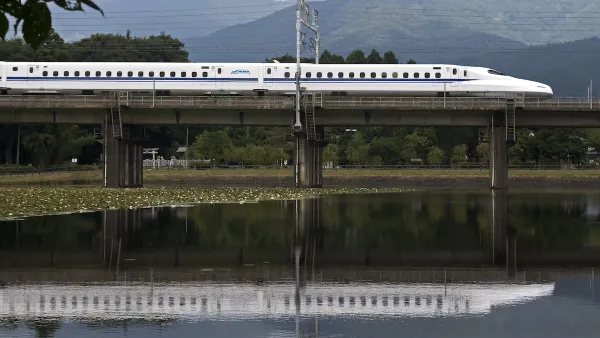Anthony Flint of the Lincoln Institute of Land Policy says the way to save high-speed rail policy is to focus on getting the two trains with the best chance of success on track.
The Lincoln Institute of Land Policy recently released a new report, High-Speed Rail: International Lessons for U.S. Policy Makers. The report says explains why it is a good idea to focus on California and the Northeast:
"These are connections between major cities that are too short to fly, and too long to drive, and could potentially open up labor markets in much the same way it works between cities in Europe. The projects are ambitious, face alignment challenges, and are not cheap – $50 billion for California (approved by citizens in a ballot question) and potentially $100 billion for a Northeast corridor replacement of the Acela, using new tracks in Connecticut and Massachusetts. But they promise a return on investment, as the international experience shows, and would create lots of jobs – 450,000 jobs through 2035 in California, according to that state's HSR Authority, and 44,000 jobs annually over 25 years plus 120,000 permanent jobs for the Northeast corridor, according to Amtrak."
For more coverage of high-speed rail, visit our sister site, The Railist.
FULL STORY: Can High Speed Rail Be Saved?

Planetizen Federal Action Tracker
A weekly monitor of how Trump’s orders and actions are impacting planners and planning in America.

Restaurant Patios Were a Pandemic Win — Why Were They so Hard to Keep?
Social distancing requirements and changes in travel patterns prompted cities to pilot new uses for street and sidewalk space. Then it got complicated.

Maui's Vacation Rental Debate Turns Ugly
Verbal attacks, misinformation campaigns and fistfights plague a high-stakes debate to convert thousands of vacation rentals into long-term housing.

Boulder Eliminates Parking Minimums Citywide
Officials estimate the cost of building a single underground parking space at up to $100,000.

Orange County, Florida Adopts Largest US “Sprawl Repair” Code
The ‘Orange Code’ seeks to rectify decades of sprawl-inducing, car-oriented development.

Maui's Vacation Rental Debate Turns Ugly
Verbal attacks, misinformation campaigns and fistfights plague a high-stakes debate to convert thousands of vacation rentals into long-term housing.
Urban Design for Planners 1: Software Tools
This six-course series explores essential urban design concepts using open source software and equips planners with the tools they need to participate fully in the urban design process.
Planning for Universal Design
Learn the tools for implementing Universal Design in planning regulations.
Heyer Gruel & Associates PA
JM Goldson LLC
Custer County Colorado
City of Camden Redevelopment Agency
City of Astoria
Transportation Research & Education Center (TREC) at Portland State University
Camden Redevelopment Agency
City of Claremont
Municipality of Princeton (NJ)





























